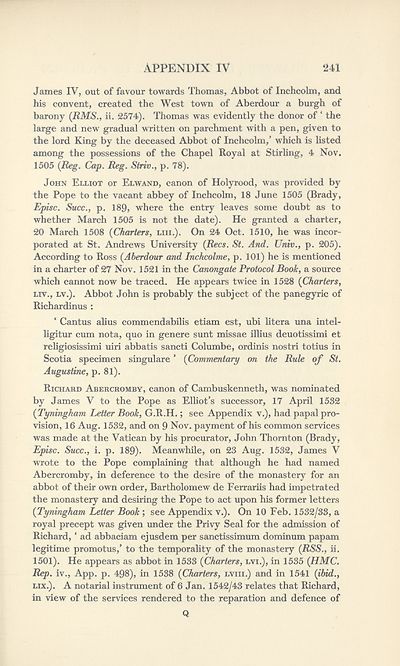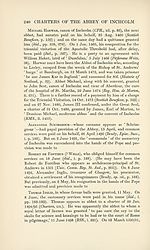Series 3 > Charters of the Abbey of Inchcolm
(294) Page 241
Download files
Complete book:
Individual page:
Thumbnail gallery: Grid view | List view

APPENDIX IV
‘241
James IV, out of favour towards Thomas, Abbot of Inchcolm, and
his convent, created the West town of Aberdour a burgh of
barony (RMS., ii. 2574). Thomas was evidently the donor of ‘ the
large and new gradual written on parchment with a pen, given to
the lord King by the deceased Abbot of Inchcolm,’ which is listed
among the possessions of the Chapel Royal at Stirling, 4 Nov.
1505 (Reg. Cap. Reg. Striv., p. 78).
John Elliot or Elwand, canon of Holyrood, was provided by
the Pope to the vacant abbey of Inchcolm, 18 June 1505 (Brady,
Episc. Succ., p. 189, where the entry leaves some doubt as to
whether March 1505 is not the date). He granted a charter,
20 March 1508 (Charters, liii.). On 24 Oct. 1510, he was incor¬
porated at St. Andrews University (Rees. St. And. Univ., p. 205).
According to Ross (Aberdour and Inchcolme, p. 101) he is mentioned
in a charter of 27 Nov. 1521 in the Canongate Protocol Book, a source
which cannot now be traced. He appears twice in 1528 (Charters,
lev., lv.). Abbot John is probably the subject of the panegyric of
Richardinus :
‘ Cantus alius commendabilis etiam est, ubi litera una intel-
ligitur cum nota, quo in genere sunt missae illius deuotissimi et
religiosissimi uiri abbatis sancti Columbe, ordinis nostri totius in
Scotia specimen singulare ’ (Commentary on the Rule of St.
Augustine, p. 81).
Richard Abercromby, canon of Cambuskenneth, was nominated
by James V to the Pope as Elliot’s successor, 17 April 1532
(Tyningham Letter Book, G.R.H.; see Appendix v.), had papal pro¬
vision, 16 Aug. 1532, and on 9 Nov. payment of his common services
was made at the Vatican by his procurator, John Thornton (Brady,
Episc. Succ., i. p. 189). Meanwhile, on 23 Aug. 1532, James V
wrote to the Pope complaining that although he had named
Abercromby, in deference to the desire of the monastery for an
abbot of their own order, Bartholomew de Ferrariis had impetrated
the monastery and desiring the Pope to act upon his former letters
(Tyningham Letter Book ; see Appendix v.). On 10 Feb. 1532/33, a
royal precept was given under the Privy Seal for the admission of
Richard, ‘ ad abbaciam ejusdem per sanctissimum dominum papam
legitime promotus,’ to the temporality of the monastery (RSS., ii.
1501). He appears as abbot in 1533 (Charters, lvi.), in 1535 (HMC.
Rep. iv., App. p. 498), in 1538 (Charters, lviii.) and in 1541 (ibid.,
lix.). A notarial instrument of 6 Jan. 1542/43 relates that Richard,
in view of the services rendered to the reparation and defence of
Q
‘241
James IV, out of favour towards Thomas, Abbot of Inchcolm, and
his convent, created the West town of Aberdour a burgh of
barony (RMS., ii. 2574). Thomas was evidently the donor of ‘ the
large and new gradual written on parchment with a pen, given to
the lord King by the deceased Abbot of Inchcolm,’ which is listed
among the possessions of the Chapel Royal at Stirling, 4 Nov.
1505 (Reg. Cap. Reg. Striv., p. 78).
John Elliot or Elwand, canon of Holyrood, was provided by
the Pope to the vacant abbey of Inchcolm, 18 June 1505 (Brady,
Episc. Succ., p. 189, where the entry leaves some doubt as to
whether March 1505 is not the date). He granted a charter,
20 March 1508 (Charters, liii.). On 24 Oct. 1510, he was incor¬
porated at St. Andrews University (Rees. St. And. Univ., p. 205).
According to Ross (Aberdour and Inchcolme, p. 101) he is mentioned
in a charter of 27 Nov. 1521 in the Canongate Protocol Book, a source
which cannot now be traced. He appears twice in 1528 (Charters,
lev., lv.). Abbot John is probably the subject of the panegyric of
Richardinus :
‘ Cantus alius commendabilis etiam est, ubi litera una intel-
ligitur cum nota, quo in genere sunt missae illius deuotissimi et
religiosissimi uiri abbatis sancti Columbe, ordinis nostri totius in
Scotia specimen singulare ’ (Commentary on the Rule of St.
Augustine, p. 81).
Richard Abercromby, canon of Cambuskenneth, was nominated
by James V to the Pope as Elliot’s successor, 17 April 1532
(Tyningham Letter Book, G.R.H.; see Appendix v.), had papal pro¬
vision, 16 Aug. 1532, and on 9 Nov. payment of his common services
was made at the Vatican by his procurator, John Thornton (Brady,
Episc. Succ., i. p. 189). Meanwhile, on 23 Aug. 1532, James V
wrote to the Pope complaining that although he had named
Abercromby, in deference to the desire of the monastery for an
abbot of their own order, Bartholomew de Ferrariis had impetrated
the monastery and desiring the Pope to act upon his former letters
(Tyningham Letter Book ; see Appendix v.). On 10 Feb. 1532/33, a
royal precept was given under the Privy Seal for the admission of
Richard, ‘ ad abbaciam ejusdem per sanctissimum dominum papam
legitime promotus,’ to the temporality of the monastery (RSS., ii.
1501). He appears as abbot in 1533 (Charters, lvi.), in 1535 (HMC.
Rep. iv., App. p. 498), in 1538 (Charters, lviii.) and in 1541 (ibid.,
lix.). A notarial instrument of 6 Jan. 1542/43 relates that Richard,
in view of the services rendered to the reparation and defence of
Q
Set display mode to:
![]() Universal Viewer |
Universal Viewer | ![]() Mirador |
Large image | Transcription
Mirador |
Large image | Transcription
Images and transcriptions on this page, including medium image downloads, may be used under the Creative Commons Attribution 4.0 International Licence unless otherwise stated. ![]()
| Scottish History Society volumes > Series 3 > Charters of the Abbey of Inchcolm > (294) Page 241 |
|---|
| Permanent URL | https://digital.nls.uk/128324303 |
|---|
| Attribution and copyright: |
|
|---|
| Description | Over 180 volumes, published by the Scottish History Society, containing original sources on Scotland's history and people. With a wide range of subjects, the books collectively cover all periods from the 12th to 20th centuries, and reflect changing trends in Scottish history. Sources are accompanied by scholarly interpretation, references and bibliographies. Volumes are usually published annually, and more digitised volumes will be added as they become available. |
|---|


